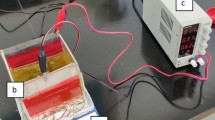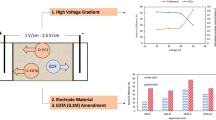Abstract
The purpose of this study was to determine the maximum amount of lead that can be electrodeposited on a graphite cathode during the application of the electro-remediation technique. The lead comes from the reduction of soil contaminated with galena. The project was divided into three sections: the first was an electrochemical study at the microelectrolysis level carried out to evaluate the behavior of galena (lead sulfide, PbS) in the cathodic zone using different electrolytes where the reduction potentials of galena were determined; the second stage consisted of laboratory experiments on the leaching of PbS in mining tailings; finally, the maximum electrodeposition of lead on graphite electrodes was evaluated. Different electrolytes at different concentrations were studied as variables. The microelectrolysis level results show that ferric chloride (FeCl3) is a faster leaching agent than hydrochloric acid (HCl) or sodium chloride. However, in the case of the electrodeposition of lead, the HCl electrolytic medium was the best of the tested solutions.








Similar content being viewed by others
References
J. Tan, Z. Cao, S. Wang, and H. Zhong, Hydrometallurgy 185, 218. (2019).
G. Flora, D. Gupta, and A. Tiwari, Interdiscip. Toxicol. 5, 47. (2012).
P.J. Landrigan Br. J. Ind. Med. 46, 593. (1989).
P. Apostoli, P. Kiss, S. Porru, J.P. Bonde, and M. Vanhoorne, Occup. Environ. Med. 55, 364. (1998).
M.F. Cabral, H.B. Suffredini, V.A. Pedrosa, S.T. Tanimoto, and S.A.S. Machado, Appl. Surf. Sci. 254, 5612. (2008).
C. Ubilla and K. Yohannessen, Rev. Méd. Clín. Las Condes. 28, 111. (2017).
Z. Wanija, S. Wei, H. Yuehua, C. Jian, and G. Zhiyong, Minerals 9, (2019).
M. Makita, M. Esperón, B. Pereyra, A. López, and E. Orrantia, BMC Biotechnol. 4, 22. (2004).
K. Laajalehto, E. Suoninen, and S. Heimala, Int. J. Miner. Process. 33, 95. (1991).
M.C. Fuerstenau, C.C. Chen, K.N. Han, and B.R. Palmer, Metall. Mater. Trans. B 17, 415. (1986).
J.E. Dutrizac, Metall. Mater. Trans. B 17, 5. (1986).
I. Cisneros-González, M.T. Oropeza-Guzmán, and I. González, Electrochim. Acta 45, 2729. (2000).
G. da Silva, Hydrometallurgy 75, 99. (2004).
J.M. Flores-Álvarez, M.A. Elizondo-Álvarez, G.I. Dávila-Pulido, A.D. Guerrero-Flores, and A. Uribe-Salas, Miner. Eng. 111, 158. (2017).
Z. Wu, D.B. Dreisinger, H. Urch, and S. Fassbender, Hydrometallurgy 142, 121. (2014).
S. Wang, Z. Fang, Y. Wang, and Y. Chen, Miner. Eng. 16, 869. (2003).
M.H. Golpayegani and A.A. Abdollahzadeh, Trans. Nonferr. Met. Soc. China 27, 2704. (2017).
A.A. Baba and F.A. Adekola, J. Saudi Chem. Soc. 16, 377. (2012).
T.Z. Sadyrbaeva, Russ. J. Electrochem. 54, 922. (2018).
A.B. Velichenko, D.V. Girenko, and F.I. Danilov, Electrochim. Acta 40, 2803. (1995).
T. Simons, A. Pearson, S. Pas, and D. MacFarlane, Electrochim. Acta 174, 712. (2015).
C.L. Hussey and X. Xu, J. Electrochem. Soc. 138, 1886. (1991).
C.O. Avellaneda, M.A. Napolitano, E.K. Kaibara, and L.O.S. Bulhões, Electrochim. Acta 50, 1317. (2005).
M. Sharon, K.S. Ramaiah, M. Kumar, M. Neumann-Spallart, and C. Levy-Clement, J. Electroanal. Chem. 436, 49. (1997).
R. Antti, HSC chemistry 6 (Outotec Research, Finlandia, 2007)
C. Núnez, F. Espiell, and J. García-Zayas, Metall. Mater. Trans. B 21, 11. (1990).
D.A. Urzúa-Abarca, J.C. Fuentes-Aceituno, A. Uribe-Salas, and J. Lee, Hydrometallurgy 176, 104. (2018).
S. Zhong and M. Skyllas-Kazacos, J. Power Sources 39, 1. (1992).
M.P. Vinod and K. Vijayamohanan, J. Appl. Electrochem. 25, 80. (1995).
Acknowledgements
The authors acknowledge CONACYT for the scholarship awarded to the student Sergio Isail Moreno Saldaña.
Author information
Authors and Affiliations
Corresponding author
Ethics declarations
Conflict of interest
The authors declare that they have no conflict of interest.
Additional information
Publisher's Note
Springer Nature remains neutral with regard to jurisdictional claims in published maps and institutional affiliations.
Rights and permissions
About this article
Cite this article
Moreno-Saldaña, S.I., Martínez-Gómez, V.J., Valle-Cervantes, S. et al. Analysis of Galena Leaching and Maximum Electrodeposition Capacity of Pb Using an Electrochemical Cell. JOM 73, 1353–1361 (2021). https://doi.org/10.1007/s11837-021-04627-9
Received:
Accepted:
Published:
Issue Date:
DOI: https://doi.org/10.1007/s11837-021-04627-9




